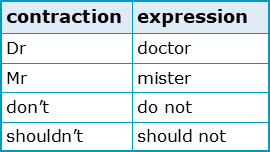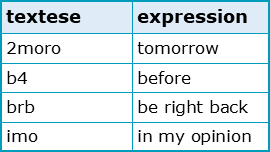What are common abbreviation types and rules?

This is the second of three chapters about Abbreviations. To complete this reader, read each chapter carefully and then unlock and complete our materials to check your understanding.
– Explore the concept of varying abbreviation types
– Explore the seven abbreviation types and discuss their uses
– Provide rules of pronunciation, punctuation and pluralisation for abbreviated word forms
Before you begin reading...
-
video and audio texts
-
knowledge checks and quizzes
-
skills practices, tasks and assignments
Chapter 2
As was explained in Chapter 1, abbreviations are very common in written English – particularly in casual, online communication. Even though many abbreviations are unacceptable in academic contexts, it’s important that learners understand that there’s still an abundance of appropriate abbreviated forms that are worth recognising and learning. Such abbreviations, however, have many types and rules regarding their formality, acceptability, pronunciation, punctuation and pluralisation. This second chapter therefore aims to deal with these concepts in turn.
Which abbreviation types are informal?
There are three types of informal abbreviation that learners of academic English should generally avoid using in their assignments:
i) Contractions
Contractions are a type of abbreviation in which some of the original expression’s letters are still included. As is shown in the following examples, when the contraction is an abbreviation of one word, that word normally retains its initial and final letters. However, when contracting multiple words, an apostrophe (’) is often used instead.

ii) Clipping
Similar to contractions, clipping is when complete syllables are instead removed from the word to create its abbreviated form:

iii) Textese
Also known as internet slang, textese or textspeak is a form of online communication that uses lots of abbreviations and that generally avoids following standardised rules of grammar, spelling and punctuation. Below are some of the most common examples that should most certainly be avoided in academic writing:

Which abbreviation types are formal?
In contrast to the three informal abbreviation types, there are four additional types of abbreviation that are generally acceptable when writing academically:
iv) Acronyms
Acronyms are a type of abbreviation in which new words are formed from the initial letters of the phrases they describe, such as ‘NATO’ from ‘North Atlantic Trade Organisation’. While newer acronyms are generally written with capital letters, once that word has become fully established in the language it tends to be written in lower case, such as the examples ‘scuba’ and ‘radar’ from Chapter 1.
v) Initialisms
Often incorrectly labelled as being acronyms, initialisms are different in that their abbreviated forms are pronounced letter by letter and not as a complete word. This can be seen in the example initialisms ‘USA’, ‘CCTV’ and ‘FBI’.
vi) Latin Abbreviations
Fairly unique to academic writing are a number of Latin abbreviations that are often used instead of their English equivalents. This is usually because there’s either no direct translation in existence in the English language or because describing that action would require an unnecessary amount of words. The Latin phrase ‘et cetera’ for example, meaning ‘and other similar things’, is often written simply as ‘etc.’.
vii) Logograms
The final type of formal abbreviation is the logogram, which is unique in that the original word is abbreviated to become a single symbol. The word ‘and’, for example, which may be written as the ampersand ‘&’, is one of the oldest forms of English logograms. Although such logograms should be used sparingly, the following examples are those that are generally acceptable in academic writing:

What are some common rules when abbreviating?
Both native and non-native students of English sometimes become confused when it comes to pronouncing, punctuating and pluralising the seven different types of abbreviation previously mentioned. Though not relevant to every scenario, the following guidelines should help you with correctly forming the most common abbreviations in the English language.
Pronunciation
Knowing when to pronounce the individual letters of the abbreviation and when to pronounce that abbreviation as a whole word can be somewhat tricky. Nevertheless, our experts have created a table that should provide some assistance in this area:

Please note that when using the indefinite articles ‘a’ or ‘an’ before an initialism (or any other abbreviation in which each individual letter is pronounced) that it’s the initial sound of the abbreviation that dictates article choice and not its spelling. For example, although ‘a’ would normally precede the letter ‘m’, with the initialism ‘MP3’ the article ‘an’ would be used instead as the initial sound is /ɛ/ and not /m/.
Punctuation
Whether or not to include full stops [.] at the end of an abbreviation or between each letter of that abbreviation can be a confusing aspect of punctuation for some students. Some of this confusion however may simply be due to differences between how American– and British-English is punctuated. Particularly with titles and honorifics such as ‘Mr’ and ‘Mrs’, the general rule here is that Americans end the abbreviation with a full stop while British speakers do not. The only instance in which British people would be correct in finishing such an abbreviation with a full stop is when the abbreviated honorific does not contain its original initial and final letters, such as the ‘p’ and ‘r’ in ‘professor’ which when abbreviated becomes ‘prof.’.
However, there is further inconsistency when adding full stops to English abbreviations. You may see both ‘USA’ and ‘U.S.A’ written in texts for example, although the former is undoubtedly much more common. Many abbreviations are also never written with full stops in either dialect, while some abbreviations such as ‘pop.’ for ‘population’ may be written with a full stop so that the word is not confused with another abbreviation, such as the ‘pop’ in ‘pop music’. Whichever dialect you do decide to follow, the most important thing is ultimately that you remain consistent within your own work.
Pluralisation
Finally, it’s important to note that some (but not all) abbreviations can be pluralised. As in the examples ‘CVs’, ‘PCs’ and ‘CEOs’, the general rule here is to simply place a lower-case ‘s’ after the abbreviation as you would any regular word. For plural abbreviations, no apostrophe (’) is needed unless the word is possessive.
Now that you understand the many different types and rules of abbreviations, the final chapter on this topic provides examples of the most common academic abbreviations across seven unique categories .
Downloadables
Once you’ve completed all three chapters about abbreviations, you might also wish to download our beginner, intermediate and advanced worksheets to test your progress or print for your students. These professional PDF worksheets can be easily accessed for only a few Academic Marks.
Collect Academic Marks
-
100 Marks for joining
-
25 Marks for daily e-learning
-
100-200 for feedback/testimonials
-
100-500 for referring your colleages/friends